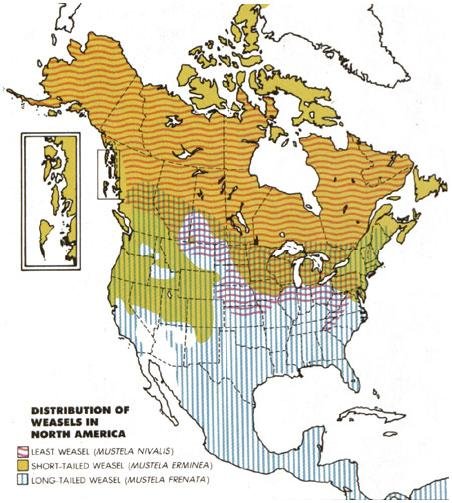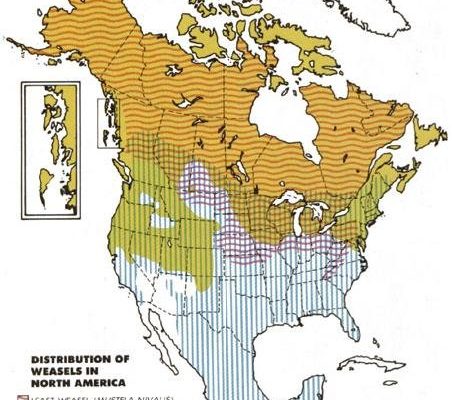
Weasels are part of the family Mustelidae, which includes otters, ferrets, and badgers. These animals are small but resourceful, and their habitats can vary widely. To understand where they live, we need to look at different types of weasels, their preferred environments, and how they adapt to various conditions. So let’s unravel the mystery of the weasel’s home!
Types of Weasels and Their Distinct Habitats
You might be surprised to learn that there are several **species of weasels**, each with its own preferred habitats. The most common ones include the **European weasel**, the **stoat** (or short-tailed weasel), and the **least weasel**. These little guys vary in size, color, and habitat preferences.
– **European Weasel**: This species usually prefers woodlands, fields, and even farmlands. They like to stay close to water sources, which provide them with food and shelter. Their agile bodies make it easy for them to navigate through dense vegetation.
– **Stoat (Short-tailed Weasel)**: Stoats are found in a range of habitats, from grasslands to forests, and even mountainous areas. They are well-known for their ability to change color with the seasons, turning white in winter to blend in with snow.
– **Least Weasel**: As the smallest member of the weasel family, the least weasel often makes its home in grasslands and shrub areas. These little critters are quite daring, often taking on prey larger than themselves!
Each species has its unique quirks, but they all share a common trait: adaptability. This flexibility in habitat choice allows them to thrive in various environments.
Geographic Distribution of Weasels
Weasels are found across much of the world, but their **distribution** can vary significantly based on the species. In general, weasels are present in North America, Europe, and parts of Asia.
– In **North America**, the **stoat** and the **least weasel** are common, roaming from the Arctic tundra down to the southern United States. They tend to thrive in diverse habitats, including urban areas, where they can find food and shelter.
– **European weasels** are primarily found throughout Europe, from the British Isles to Scandinavian countries. Their presence is evident in both rural and urban settings, as long as there are plentiful resources.
– Weasels are often less common in tropical regions. They tend to prefer the temperate zones where the climate supports their hunting and burrowing habits.
Despite their small size, weasels are hardy survivors, capable of adjusting to different environments as needed.
Preferred Habitats: Forests, Grasslands, and More
When it comes to specific habitats, weasels have a few favorites. They typically gravitate toward places that offer shelter, food, and a chance to hide from predators. Let’s break down some common habitats:
– **Forests**: Many weasels thrive in wooded areas. The cover provided by trees, bushes, and underbrush creates an excellent hunting ground. You might spot them sneaking around tree roots or darting through the leaf litter.
– **Grasslands**: Open fields and meadows are like a buffet for weasels. The tall grasses provide camouflage for stalking prey like rabbits or rodents. Plus, they can easily burrow into the ground to create dens for shelter.
– **Wetlands and Riverbanks**: Areas near water sources are particularly attractive to weasels. They often hunt near rivers and lakes, where they can find fish and small mammals. These environments also offer plenty of places to hide from larger predators.
Weasels are quite resourceful, and their choice of habitat can change based on food availability and seasonal changes.
How Weasels Adapt to Their Environments
One of the most fascinating aspects of weasels is their ability to adapt. They have evolved over time to thrive in various habitats. Here’s how they manage this impressive feat:
– **Camouflage**: Weasels have coats that change color with the seasons, helping them blend into their surroundings. A stoat, for instance, turns white in winter to match the snow. This camouflage is crucial for both hunting and avoiding other predators.
– **Hunting Techniques**: Weasels are agile and quick, which helps them chase down prey. They often take advantage of their slender bodies to fit into small spaces, surprising their targets. This adaptability in hunting allows them to live almost anywhere there’s food.
– **Den Construction**: Weasels often dig their own burrows or take over existing ones from other animals. These dens provide a safe space for resting and raising their young. The ability to create or find shelter is vital for survival in different habitats.
These traits not only help weasels survive but also thrive in increasingly changing environments.
The Role of Weasels in Their Ecosystem
Weasels play a crucial role in their ecosystems. As predators, they help maintain a balance in the populations of rodents and other small mammals. Here’s why this is important:
– **Pest Control**: By controlling rodent populations, weasels contribute to the health of the environment. Too many rodents can lead to crop damage and disease spread, so weasels act as natural pest controllers.
– **Prey for Other Animals**: While weasels are fierce hunters, they’re also prey for larger animals. Eagles, hawks, and even domestic pets can target these little creatures. This relationship helps maintain the food chain in their habitats.
– **Biodiversity**: The presence of weasels can be an indicator of a healthy ecosystem. A diverse range of species supports a robust environment, and weasels are a critical part of that mix.
Protecting weasels and their habitats is essential for maintaining overall environmental balance.
Conservation Status and Threats
While weasels are adaptable, they are not completely immune to threats. Their conservation status varies by species, but some face challenges from habitat loss, climate change, and human activities.
– **Habitat Loss**: Urban development and agricultural expansion often destroy the habitats that weasels rely on. As forests and grasslands disappear, their living spaces shrink, making it harder for them to find food and shelter.
– **Climate Change**: Changes in temperature and weather patterns can affect weasel behaviors and their food sources. For example, if winters are shorter, it might disrupt their seasonal camouflage changes.
– **Human Interactions**: Increased interaction with humans can lead to conflicts. Pets and cars are significant threats to their populations, especially in suburban areas.
Conservation efforts are vital to ensure that weasels continue to thrive. Protected areas and wildlife corridors can help maintain their habitats and support their populations.
So, where do weasels live? In short, they inhabit a range of environments, from forests to grasslands, and are found across multiple continents. Their adaptability allows them to thrive in various habitats, making them fascinating little animals.
Understanding **weasels**—their habitats, behaviors, and roles in the ecosystem—can help us appreciate their place in nature. By protecting their environments, we can help ensure that these agile creatures continue to thrive for generations to come. It’s a small but significant step toward preserving the balance of our ecosystems. If you ever spot a weasel darting about, take a moment to admire its cleverness and resilience!

